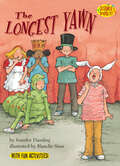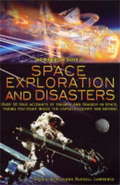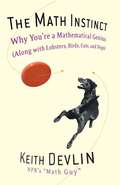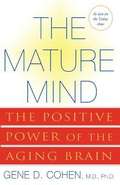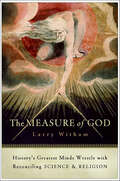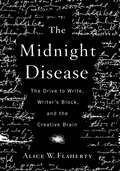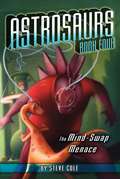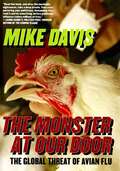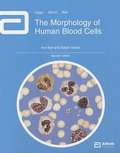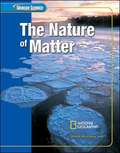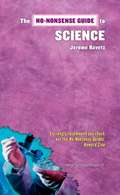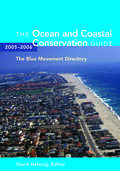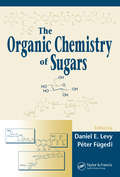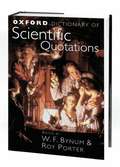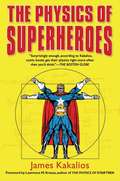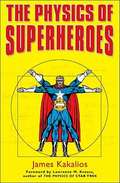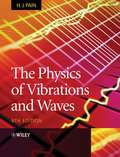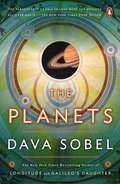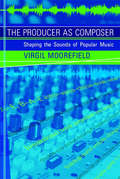- Table View
- List View
The Longest Yawn (Science Solves It!)
by Jennifer DusslingSolve kid-sized dilemmas and mysteries with the Science Solves It! series. These fun books for kids ages 5–8 blend clever stories with real-life science. Why did the dog turn green? Can you control a hiccup? Is that a UFO? Find the answers to these questions and more as kid characters dive into physical, life, and earth sciences. Barry's teacher says that acting is mainly about control. But how can Barry control hiccups and yawns? Will he ever be a real actor? Books in this perfect STEM series will help kids think like scientists and get ahead in the classroom. Activities and experiments are included in every book! (Level Two; Science topic: Involuntary reflexes)
The Mammoth Book of Space Exploration and Disaster (Mammoth Books #358)
by Richard Russell LawrenceIn the words of those who trod the void and those at missioncontrol, here are over 50 of the greatest true stories of suborbital,orbital and deep-space exploration. From Apollo 8'sfirst view of a fractured, tortured landscape of craters on the'dark side' of the Moon to the series of cliff-hanger crisesaboard space station Mir, they include moments ofextraordinary heroic achievement as well as episodes of terriblehuman cost. Among the astronauts and cosmonauts featured areJohn Glenn, Pavel Beyayev, Jim Lovell, Neil Armstrong, BuzzAldrin, Valery Korzun, Vasily Tsibliyev and Michael Foale.Includes • First walk in space by Sergei Leonov and histraumatic return to Earth • Apollo 13's problem - the classic,nail-biting account of abandoning ship on the way to theMoon • Docking with the frozen, empty Salyut 7 space stationthat had drifted without power for eight months • Progresscrashes into Mir - the astronauts survive death by a hair'sbreadth • Jerry Linenger's panic attack during a space walk,'just out there dangling'.
The Mammoth Book of Space Exploration and Disaster: Over 50 True Accounts Of Triumph And Tragedy In Space, Taking You Right Inside The Capsule Cockpit And Beyond
by Richard Russell LawrenceIn the words of those who trod the void and those at missioncontrol, here are over 50 of the greatest true stories of suborbital,orbital and deep-space exploration. From Apollo 8'sfirst view of a fractured, tortured landscape of craters on the'dark side' of the Moon to the series of cliff-hanger crisesaboard space station Mir, they include moments ofextraordinary heroic achievement as well as episodes of terriblehuman cost. Among the astronauts and cosmonauts featured areJohn Glenn, Pavel Beyayev, Jim Lovell, Neil Armstrong, BuzzAldrin, Valery Korzun, Vasily Tsibliyev and Michael Foale.Includes ? First walk in space by Sergei Leonov and histraumatic return to Earth ? Apollo 13's problem - the classic,nail-biting account of abandoning ship on the way to theMoon ? Docking with the frozen, empty Salyut 7 space stationthat had drifted without power for eight months ? Progresscrashes into Mir - the astronauts survive death by a hair'sbreadth ? Jerry Linenger's panic attack during a space walk,'just out there dangling'.
The Math Instinct: Why You're a Mathematical Genius (Along with Lobsters, Birds, Cats, and Dogs)
by Keith DevlinThere are two kinds of math: the hard kind and the easy kind. The easy kind, practiced by ants, shrimp, Welsh Corgis - and us - is innate. But what innate calculating skills do we humans have? Leaving aside built-in mathematics, such as the visual system, ordinary people do just fine when faced with mathematical tasks in the course of the day. Yet when they are confronted with the same tasks presented as "math," their accuracy often drops. If we have innate mathematical ability, why do we have to teach math and why do most of us find it so hard to learn? Are there tricks or strategies that the ordinary person can do to improve mathematical ability? Can we improve our math skills by learning from dogs, cats, and other creatures that "do math?" The answer to each of these questions is a qualified yes. All these examples of animal math suggest that if we want to do better in the formal kind of math, we should see how it arises from natural mathematics. From NPR's "Math Guy," The Math Instinct is a real celebration of innate math sense and will provide even the most number-phobic readers with confidence in their own mathematical abilities.
The Mature Mind: The Positive Power of the Aging Brain
by Gene D. CohenPsychological aspects of the aging brain
The Measure of God: History's Greatest Minds Wrestle with Reconciling Science & Religion
by Larry WithamThe Measure of God is a lively historical narrative offering the reader a sense for what has taken place in the God and science debate over the past century. Modern science came of age at the cusp of the twentieth century. It was a period marked by discovery of radio waves and x rays, use of the first skyscraper, automobile, cinema, and vaccine, and rise of the quantum theory of the atom. This was the close of the Victorian age, and the beginning of the first great wave of scientific challenges to the religious beliefs of the Christian world. Religious thinkers were having to brace themselves. Some raced to show that science did not undermine religious belief. Others tried to reconcile science and faith, and even to show that the tools of science, facts and reason, could support knowledge of God. In the English speaking world, many had espoused such a project, but one figure stands out. Before his death in 1887, the Scottish judge Adam Gifford endowed the Gifford Lectures to keep this debate going, a science haunted debate on "all questions about man's conception of God or the Infinite." The list of Gifford lecturers is a veritable Who's Who of modern scientists, philosophers and theologians: from William James to Karl Barth, Albert Schweitzer to Reinhold Niebuhr, Niels Bohr to Iris Murdoch, from John Dewey to Mary Douglas.
The Midnight Disease: The Drive to Write, Writer's Block, and the Creative Brain
by Alice W. Flaherty&“An original, fascinating, and beautifully written reckoning . . . of that great human passion: to write.&”—Kay Redfield Jamison, national bestselling author of An Unquiet Mind Why is it that some writers struggle for months to come up with the perfect sentence or phrase while others, hunched over a keyboard deep into the night, seem unable to stop writing? In The Midnight Disease, neurologist Alice W. Flaherty explores the mysteries of literary creativity: the drive to write, what sparks it, and what extinguishes it. She draws on intriguing examples from medical case studies and from the lives of writers, from Franz Kafka to Anne Lamott, from Sylvia Plath to Stephen King. Flaherty, who herself has grappled with episodes of compulsive writing and block, also offers a compelling personal account of her own experiences with these conditions. &“[Flaherty] is the real thing . . . and her writing magically transforms her own tragedies into something strange and whimsical almost, almost funny.&”—The Washington Post &“This is interesting, heated stuff.&”—San Francisco Chronicle &“Brilliant . . . [a] precious jewel of a book . . . that sparkles with some fresh insight or intriguing fact on practically every page.&”—Seattle Post-Intelligencer &“Flaherty mixes memoir, meditation, compendium and scholarly reportage in an odd but absorbing look at the neurological basis of writing and its pathologies . . . Writers will delight in the way information and lore are interspersed.&”—Publishers Weekly
The Mind-Swap Menace
by Steve Cole Woody FoxSmashing space stations! While on another vital mission, Captain Teggs and his crew nearly crash into an unknown spaceship. But when it spins around, the gaping hole and the mark of the meat-eaters reveal that it's a carnivore space station! What's it doing in the middle of the Vegetarian Sector? Teggs and his chief engineer, Iggy, board the space station to check it out. They soon discover that the only remaining dinosaurs in the ship are also two of the most evil criminals in the universe, and one of them is a genius. He's built a machine that can swap minds, and he's going to use it on Teggs and Iggy so he and his partner can fulfill their dreams of riches! It's up to Teggs and his crew to stop them, but how can they when no one knows who is who?
The Mind-Swap Menace
by Steve Cole Woody FoxSmashing space stations! While on another vital mission, Captain Teggs and his crew nearly crash into an unknown spaceship. But when it spins around, the gaping hole and the mark of the meat-eaters reveal that it's a carnivore space station! What's it doing in the middle of the Vegetarian Sector? Teggs and his chief engineer, Iggy, board the space station to check it out. They soon discover that the only remaining dinosaurs in the ship are also two of the most evil criminals in the universe, and one of them is a genius. He's built a machine that can swap minds, and he's going to use it on Teggs and Iggy so he and his partner can fulfill their dreams of riches! It's up to Teggs and his crew to stop them, but how can they when no one knows who is who?
The Mold In Dr. Florey's Coat: The Story Of The Penicillin Miracle
by Eric LaxAlexander Fleming's discovery of penicillin in his London laboratory in 1928 and its eventual development as the first antibiotic by a team at Oxford University headed by Howard Florey and Ernst Chain in 1942 led to the introduction of the most important family of drugs of the twentieth century. <P><P> Yet credit for penicillin is largely misplaced. Neither Fleming nor Florey and his associates ever made real money from their achievements; instead it was the American labs that won patents on penicillin's manufacture and drew royalties from its sale. Why this happened, why it took fourteen years to develop penicillin, and how it was finally done is a fascinating story of quirky individuals, missed opportunities, medical prejudice, brilliant science, shoestring research, wartime pressures, misplaced modesty, conflicts between mentors and their protegees, and the passage of medicine from one era to the next. <P> Includes Bibliographic references and extensive notes. At the end of the book, after the index are pages of photo captions with some image descriptions.
The Monster at Our Door: The Global Threat of Avian Flu
by Mike DavisIn this urgent and extraordinarily frightening book, Mike Davis reconstructs the scientific and political history of a viral apocalypse in the making, exposing the central roles of agribusiness and the fast-food industries, abetted by corrupt governments, in creating the ecological conditions for the emergence of this new plague. He also details the scandalous failure of the Bush administration, obsessed with hypothetical "bio-terrorism," to safeguard Americans from the greatest biological threat since HIV/AIDS.
The Morphology of Human Blood Cells (Seventh Edition)
by Ann Bell Sabah SallahThe book portrays the morphologic characteristics of normal and pathologic cells in blood and bone marrow. It will benefit medical students, student medical technologists, and other health science students who are learning to identify the various types of blood cells.
The Nature of Matter
by Glencoe McGraw-Hill StaffDiscover the flexibility to teach science your way. "The Nature of Matter," as a part of the Glencoe Science 15-Book Series, provides students with accurate and comprehensive coverage of matter and its properties, including the Periodic Table. The strong content coverage integrates a wide range of hands-on experiences, critical-thinking opportunities, and real-world applications. The modular approach allows you to mix and match books to meet your curricula.
The No-Nonsense Guide to Science
by Jerome RavetzScience is the great intellectual adventure, but can also be an instrument of profit, power, and privilege. Wrongly used, it might yet make the twenty-first century our last. To make sense of this, we need to let go of old ideas and assumptions.<P><P>This No-Nonsense Guide to Science introduces a new way of thinking about science, moving away from ideas of perfect certainty and objectivity. We must accept uncertainty and ignorance in the field, as well as the need for citizens' participation in the policies involving science.
The Ocean and Coastal Conservation Guide 2005-2006: The Blue Movement Directory
by David HelvargA new environmental movement is emerging to help combat threats to America's oceans and coasts, with hundreds of local and regional groups as well as dozens of national and international organizations being formed. The Ocean and Coastal Conservation Guide represents a comprehensive guide to this new "Blue Movement." This one-of-a-kind new reference details more than 2,000 organizations and institutions that are working to understand, protect, and restore our ocean and coastal areas. For each entry, the book gives contact information including phone and fax numbers, email addresses, web addresses and a brief description of program areas of interest. Along with the state-by-state listings of groups, the directory includes three detailed sections that identify relevant government agencies, academic marine programs, and marine and coastal parks and protected areas. To be published biennially, The Ocean and Coastal Conservation Guide is a vital new resource for anyone interested in the growing community of people working to protect and restore our coastal lands and waters.
The Organic Chemistry of Sugars
by Daniel E. Levy Péter FügediIntrigued as much by its complex nature as by its outsider status in traditional organic chemistry, the editors of The Organic Chemistry of Sugars compile a groundbreaking resource in carbohydrate chemistry that illustrates the ease at which sugars can be manipulated in a variety of organic reactions. Each chapter contains numerous examples demonst
The Oxford Dictionary of Scientific Quotations
by Roy Porter W. F. BynumThe original words announcing great scientific discoveries, from the first 'Eureka!' to the cloning of Dolly the sheep, can all be found in this fascinating addition to the world-famous Oxford Quotations series. An essential reference tool, put together over fifteen years with the assistance of a distinguished team of specialist advisers, it includes full author descriptions, exact sources, and a word-finding index for easy reference. Scholarly but accessible, it also presents the human face of science, as scientists reflect on achievements and failures in their own lives and those of others. For example, you've probably already hear Darwin's own thoughts on natural selection, but how about his assessment of the pros and cons of marriage? From Archimedes to Einstein and beyond, the Oxford Dictionary of Scientific Quotations charts the progress of the great ideas of science. It is an engaging and surprising read for all lovers of science, history, or wit.
The Physics of Superheroes
by James KakaliosWhat did the Flash know about the Special Theory of Relativity that you do not? Why did Ant-Man have so much difficulty with a half-filled bathtub? Kakalios combines his love for comic books and the startling accurate ways they present physics with his love of explaining physics to undergraduates and those of us destined to never get beyond the comic book stage. While filling us in on why spending your allowance on x-ray glasses is a poor investment, Kakalios covers mechanics (including Newton's Law of Gravity, the properties of matter and the cube-square law) energy (including conservation and Ampere's Law), and modern physics (including quantum mechanics, solid-state physics and tunneling phenomena). In a final section, Kakalios also contemplates a series of superhero bloopers, proving that sometimes having mutant powers and three bucks is only good for a small cappuccino.
The Physics of Superheroes
by James KakaliosA complete update to the hit book on the real physics at work in comic books, featuring more heroes, more villains, and more science Since 2001, James Kakalios has taught "Everything I Needed to Know About Physics I Learned from Reading Comic Books," a hugely popular university course that generated coast-to-coast media attention for its unique method of explaining complex physics concepts through comics. With The Physics of Superheroes, named one of the best science books of 2005 by Discover, he introduced his colorful approach to an even wider audience. Now Kakalios presents a totally updated, expanded edition that features even more superheroes and findings from the cutting edge of science. With three new chapters and completely revised throughout with a splashy, redesigned package, the book that explains why Spider-Man's webbing failed his girlfriend, the probable cause of Krypton's explosion, and the Newtonian physics at work in Gotham City is electrifying from cover to cover. .
The Physics of Vibrations and Waves
by H. J. PainThe main theme of this highly successful book is that the transmission of energy by wave propogation is fundamental to almost every branch of physics. Therefore, besides giving students a thorough grounding in the theory of waves and vibrations, the book also demonstrates the pattern and unity of a large part of physics.This new edition has been thoroughly revised and has been redeisgned to meet the best contemporary standards. It includes new material on electron waves in solids using the Kronig-Penney model to show how their allowed energies are limited to Brillouin zones, The role of phonons is also discussed. An Optical Transform is used to demonstrate the modern method of lens testing. In the last two chapters the sections on chaos and solitons have been reduced but their essential contents remain.As with earlier editions, the book has a large number of problems together with hints on how to solve them. The Physics of Vibrations and Waves, 6th Edition will prove invaluable for students taking a first full course in the subject across a variety of disciplines particularly physics, engineering and mathematics.
The Planets
by Dava SobelA rich exploration of our solar system--what we know, what we wonder, what we believe.
The Planets
by Dava SobelAfter the huge national and international success of LONGITUDE and GALILEO'S DAUGHTER, Dava Sobel tells the human story of the nine planets of our solar system. This groundbreaking new work traces the lives of each member of our solar family, from myth and history, astrology and science fiction, to the latest data from the modern era's robotic space probes. Whether revealing what hides behind Venus's cocoon of acid clouds, describing Neptune's 'complex beauty in subtle stripes and spots of royal to navy blue, azure, turquoise, and aquamarine', or capturing first-hand the excitement at the Jet Propulsion Laboratory when the first pictures from Cassini at Saturn were recently beamed to earth, Dava Sobel's unique tour of the solar system is filled with fascination and beauty. In lyrical prose interspersed with poems by Tennyson, Blake and others, The Planets gives a breathtaking, intimate view of those heavenly bodies that have captured the imagination since humanity's first glimpse of the glittering night skies. This extraordinary book of science, history, biography and storytelling will engage and delight. It is at once timely and timeless, and of infinite relevance to this age in which new planets are being discovered elsewhere in our galaxy, around stars other than the Sun.
The Producer as Composer: Shaping the Sounds of Popular Music
by Virgil MoorefieldThe evolution of the record producer from organizer to auteur, from Phil Spector and George Martin to the rise of hip-hop and remixing. In the 1960s, rock and pop music recording questioned the convention that recordings should recreate the illusion of a concert hall setting. The Wall of Sound that Phil Spector built behind various artists and the intricate eclecticism of George Martin's recordings of the Beatles did not resemble live performances—in the Albert Hall or elsewhere—but instead created a new sonic world. The role of the record producer, writes Virgil Moorefield in The Producer as Composer, was evolving from that of organizer to auteur; band members became actors in what Frank Zappa called a "movie for your ears." In rock and pop, in the absence of a notated score, the recorded version of a song—created by the producer in collaboration with the musicians—became the definitive version. Moorefield, a musician and producer himself, traces this evolution with detailed discussions of works by producers and producer-musicians including Spector and Martin, Brian Eno, Bill Laswell, Trent Reznor, Quincy Jones, and the Chemical Brothers. Underlying the transformation, Moorefield writes, is technological development: new techniques—tape editing, overdubbing, compression—and, in the last ten years, inexpensive digital recording equipment that allows artists to become their own producers. What began when rock and pop producers reinvented themselves in the 1960s has continued; Moorefield describes the importance of disco, hip-hop, remixing, and other forms of electronic music production in shaping the sound of contemporary pop. He discusses the making of Pet Sounds and the production of tracks by Public Enemy with equal discernment, drawing on his own years of studio experience. Much has been written about rock and pop in the last 35 years, but hardly any of it deals with what is actually heard in a given pop song. The Producer as Composer tries to unravel the mystery of good pop: why does it sound the way it does?
The Proteomics Protocols Handbook
by John M. WalkerHands-on researchers describe in step-by-step detail 73 proven laboratory methods and bioinformatics tools essential for analysis of the proteome. These cutting-edge techniques address such important tasks as sample preparation, 2D-PAGE, gel staining, mass spectrometry, and post-translational modification. There are also readily reproducible methods for protein expression profiling, identifying protein-protein interactions, and protein chip technology, as well as a range of newly developed methodologies for determining the structure and function of a protein. The bioinformatics tools include those for analyzing 2D-GEL patterns, protein modeling, and protein identification. All laboratory-based protocols follow the successful Methods in Molecular BiologyTM series format, each offering step-by-step laboratory instructions, an introduction outlining the principle behind the technique, lists of the necessary equipment and reagents, and tips on troubleshooting and avoiding known pitfalls.
The Quantum Enigma: Finding the Hidden Key
by Wolfgang SmithFollowing the overthrow of the classical world picture by the findings of quantum mechanics, physicists have proposed a broad gamut of alternative world views. This book begins with the major recognition that each of these suffers from a certain 'residual Cartesianism' that has been smuggled in unconsciously. It turns out that the moment one discards this hidden and problematic premise, quantum theory begins to 'make sense' in a way that it never has before. As the author shows, it is now possible, for the first time, to integrate the findings of quantum physics into a world view that is neither forced nor ad hoc, but conforms to the permanent intuitions of mankind. Surprisingly, this treatise can be read not only by scientists, but also by readers unacquainted with the technical conceptions of physics or the quantum-reality literature.
